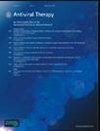Comparison of three galenic forms of lamivudine in young West African children living with Human Immunodeficiency Virus
IF 2.3
4区 医学
Q4 INFECTIOUS DISEASES
引用次数: 0
Abstract
Background Few pharmacokinetic data were reported on dispersible tablets despite their increasing use. One hundred fifty HIV-infected children receiving lamivudine were enrolled in the MONOD ANRS 12,206 trial. Three galenic forms were administered: liquid formulation, tablet form and dispersible scored tablet. Method HIV-infected children <4 years old were enrolled in the MONOD ANRS 12,206 trial designed to assess the simplification of a successful 12-months lopinavir-based antiretroviral treatment with efavirenz. Lamivudine plasma concentrations were analysed using nonlinear mixed effects modelling approach. Results One hundred and fifty children (age: 2.5 years (1.9–3.2), weight 11.1 (9.5–12.5) kg (median (IQR)) were included in this study. Over the study period, 79 received only the syrup form, 29 children switched from syrup form to tablet 3TC/AZT form, 36 from syrup to the orodispersible ABC/3TC form and two from the 3TC/AZT form to the orodispersible ABC/3TC form. The 630 lamivudine concentrations were best described by a two-compartment model allometrically scaled. Galenic form had no significant effect on 3TC pharmacokinetic. Conclusion This trial provided an opportunity to compare three galenic forms (liquid formulation, tablet form and dispersible scored tablet) of lamivudine in the target population of young HIV–1-infected children. Galenic form had no significant effect on lamivudine pharmacokinetics.三种半乳糖形式拉米夫定在患有人类免疫缺陷病毒的西非儿童中的比较
背景:尽管分散片的使用越来越广泛,但其药代动力学数据报道较少。150名接受拉米夫定治疗的艾滋病毒感染儿童参加了MONOD ANRS 12,206试验。分三种剂型:液体剂型、片剂剂型和分散记分片剂型。方法在MONOD ANRS 12,206试验中招募了4岁以下的hiv感染儿童,该试验旨在评估以依非韦伦为基础的12个月洛匹那韦抗逆转录病毒治疗的成功简化。采用非线性混合效应建模方法分析拉米夫定血药浓度。结果150名儿童(年龄:2.5岁(1.9-3.2岁),体重11.1 (9.5-12.5)kg(中位(IQR))纳入本研究。在研究期间,79名儿童只服用糖浆剂型,29名儿童从糖浆剂型改为片剂3TC/AZT剂型,36名儿童从糖浆剂型改为可分散的ABC/3TC剂型,2名儿童从3TC/AZT剂型改为可分散的ABC/3TC剂型。630拉米夫定浓度最好用异速缩放的双室模型来描述。盖伦形式对3TC药动学无显著影响。结论本试验为拉米夫定三种galenic剂型(液体剂型、片剂剂型和分散计分片剂型)在hiv - 1感染儿童目标人群中的应用提供了一个比较的机会。盖伦型对拉米夫定的药代动力学无显著影响。
本文章由计算机程序翻译,如有差异,请以英文原文为准。
求助全文
约1分钟内获得全文
求助全文
来源期刊

Antiviral Therapy
医学-病毒学
CiteScore
2.60
自引率
8.30%
发文量
35
审稿时长
4-8 weeks
期刊介绍:
Antiviral Therapy (an official publication of the International Society of Antiviral Research) is an international, peer-reviewed journal devoted to publishing articles on the clinical development and use of antiviral agents and vaccines, and the treatment of all viral diseases. Antiviral Therapy is one of the leading journals in virology and infectious diseases.
The journal is comprehensive, and publishes articles concerning all clinical aspects of antiviral therapy. It features editorials, original research papers, specially commissioned review articles, letters and book reviews. The journal is aimed at physicians and specialists interested in clinical and basic research.
 求助内容:
求助内容: 应助结果提醒方式:
应助结果提醒方式:


